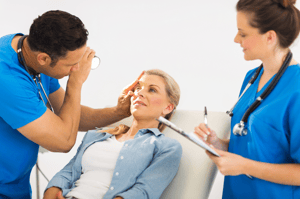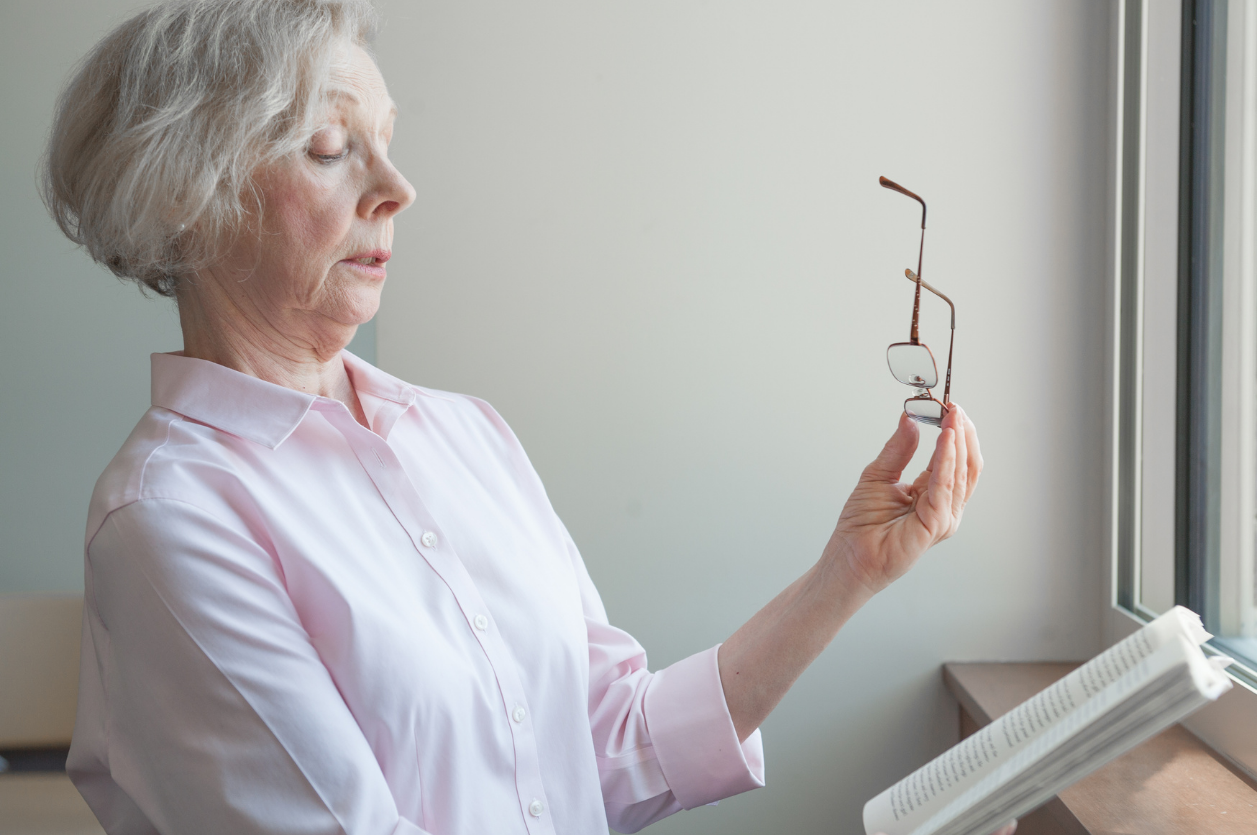Treatment Options for Macular Degenerative Disease
Age-related macular degeneration disease (AMD) affects 10-15 million people in the U.S., according to the American Academy of Ophthalmology (AAO).
Unfortunately, there's no cure, but treatment for AMD may slow the progression and help people keep some of their vision. Early detection is vital.
While everyone should go for regular eye exams, the AAO recommends that those with at least two of the risk factors listed below should get a thorough eye examination to check for AMD and to learn what can be done to reduce the risks. Consider scheduling an eye examination soon if:
- you smoke.
- you’re obese.
- you’re over age 60.
- you have high blood pressure.
- you have a family history of AMD.
Two Types of AMD
The two basic types of AMD are dry and wet, and while they have similar symptoms, there are some important differences.
Dry AMD
Dry AMD has pain-free symptoms that develop gradually, and it typically affects both eyes. If you have it in only one eye, your “good” eye can compensate, which means you might not notice any symptoms. This highlights the importance of regular eye exams.
Wet AMD
Wet AMD is generally caused by abnormal blood vessels that leak fluid or blood into the macula.
The wet type of AMD always begins as the dry type. Early detection and treatment of wet macular degeneration is important as it may help curb vision loss and, in some cases, allow vision recovery. Wet AMD usually appears suddenly and rapidly worsens.
Dry AMD Treatment
Currently, there's no cure for dry AMD. If it is diagnosed early, there are things you can do to slow the progression, like taking vitamin supplements, eating a healthy diet, and not smoking. Monitoring and treating high blood pressure can also help slow the progression.
Even though there are limited treatment options, there are some things that can help patients adapt to living with dry AMD.
Low Vision Rehabilitation
AMD doesn't affect the side (peripheral) vision, but it can reduce or eliminate the central vision, which is needed for driving, reading and recognizing people. Working with a low vision rehabilitation specialist, occupational therapist, and eye doctor can help patients find ways to adapt to vision challenges.
Implanting a Telescopic Lens
 For selected people with advanced AMD in both eyes, surgery to implant a telescopic lens in one eye can help improve vision. According to Mayo Clinic, the lens magnifies the patient’s field of vision. The implant may help patients by improving both distance and close-up vision, but the downside is that it leaves patients with a very narrow field of vision.
For selected people with advanced AMD in both eyes, surgery to implant a telescopic lens in one eye can help improve vision. According to Mayo Clinic, the lens magnifies the patient’s field of vision. The implant may help patients by improving both distance and close-up vision, but the downside is that it leaves patients with a very narrow field of vision.
Ongoing Treatment Research for Dry AMD
There’s a lot of research around dry AMD to sift through, says Prevent Blindness. What kinds of discoveries are happening?
A phase two study conducted in 2019 has found that a new drug may offer safe and effective treatment options to improve the vision of patients with dry AMD. This new treatment involves injecting the drug risuteganib into the eye. The study has suggested this treatment is effective and has no serious side effects while offering increased visual acuity.
Wet AMD Treatment
For wet AMD, there are treatments that may help slow the progression of the disease and preserve existing vision. If started early enough, these treatments can help patients recover some lost vision.
Medications
VEGF is an acronym for vascular endothelial growth factor. In the normal life of the human body, VEGF supports the growth of new blood vessels. In the case of macular health, however, VEGF is unhealthy because it promotes the growth of new, underdeveloped blood vessels that can leak, causing retinal scarring and killing macular cells.
Three anti-VEGF drugs are considered the first line of treatment for wet AMD in all stages. They help stop the growth of new blood vessels.
These drugs include:
- Bevacizumab (Avastin)
- Ranibizumab (Lucentis)
- Aflibercept (Eylea)
Injected into the affected eye, these medications can help patients maintain their sight longer but may need to be injected every four weeks to maintain the benefits.
Therapies
- Photodynamic therapy. This is sometimes used to treat abnormal blood vessels at the center of the macula. A doctor injects a drug called verteporfin (Visudyne) into a vein in the arm, which travels to blood vessels in the eye. Then, a focused light from a special laser is used on the abnormal blood vessels in the eye to activate the drug, closing the blood vessels.
This therapy may improve vision as well as reduce the rate of vision loss, though repeated treatments may be needed over time.
- Photocoagulation. For photocoagulation therapy, the doctor uses a high-energy laser beam to seal abnormal blood vessels under the edges of the macula. The aim is to minimize further damage to the macula.
Unfortunately, few are candidates for this treatment—it generally isn't an option for those with abnormal blood vessels directly under the center of the macula. And the more damaged the macula is at the time of treatment, the lower the rate of success.
- Low vision rehabilitation. As with dry AMD, wet AMD doesn't affect side (peripheral) vision, but it can reduce or eliminate central vision. Working with a low vision rehabilitation specialist, an occupational therapist and an eye doctor can help patients determine ways to adapt to their vision changes.
New Treatment Research for Wet AMD
Prevent Blindness says that Genentech has announced positive results from a phase two study of its port delivery system with Lucentis in people with wet AMD.
This treatment involves a small, refillable implant, slightly longer than a grain of rice, being placed in the eye. This port system is designed to allow people with wet AMD to go several months without needing to visit their eye doctor for treatment.
Most of the patients enrolled in the trial went six months or longer between the implanting of the device and the first required refill. The vision outcomes were similar to those receiving monthly injections.
Vision Source Plano for Early AMD Detection
Early detection is the key to effective treatment of any kind of AMD.
At Vision Source Plano, our individualized approach to optometry makes Dr. Malone and staff the eye and vision care providers of choice in the Plano area. We offer the following services:
- Complete eye exams
- Contact lenses and glasses
- Glaucoma testing
- Pre/post-operative care
- Dry eye treatment and diagnosis
We also work with other practitioners in the control and treatment of diabetic eye disease.
We offer financing options and work with your vision insurance provider to ensure the best in eye health and vision care.
For a complete list of services, visit our services page or call our Plano office at (972) 612-2099.
At Vision Source Plano, we are dedicated to providing high-quality optometry services in a comfortable environment.
Call us at (972) 612-2099, or schedule an appointment online today.
Disclaimer: The content on this blog is not intended to be a substitute for professional medical advice, diagnosis, or treatment. Always seek the advice of qualified health providers with questions you may have regarding medical conditions.








